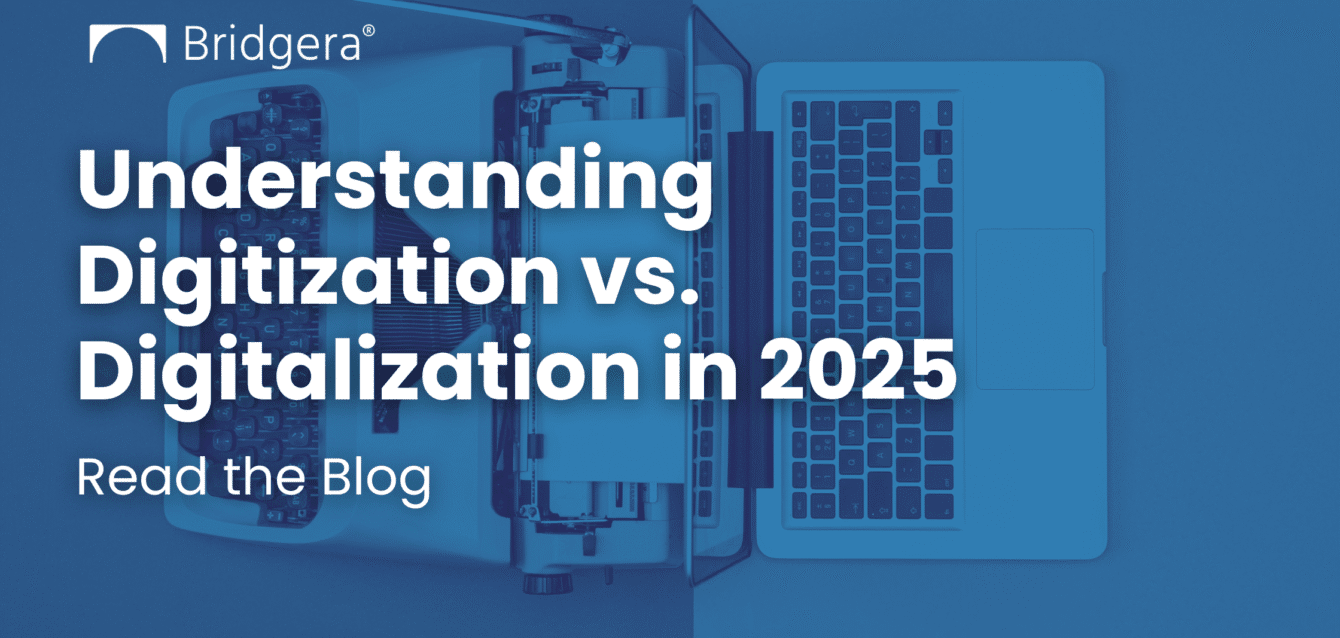Introduction: Why This Topic Matters More Than Ever
Digital transformation has become the defining theme for businesses in 2025. With the explosion of IoT (Internet of Things) and AIoT (Artificial Intelligence of Things), organizations across industries are rethinking how they operate, deliver value, and stay competitive. Yet one persistent challenge remains: the confusion between digitization and digitalization.
Although often used interchangeably, these terms represent very different stages of a company’s digital journey. Misunderstanding them can lead to poorly aligned strategies, wasted investments, and missed opportunities. In this blog, we’ll clarify what digitization and digitalization mean, how they differ, why both matter, and how Bridgera applied these principles in our work with JF Petroleum.
What Is Digitization?
Digitization is the process of converting analogue data into digital form. It’s the first step in any organization’s digital journey.
Examples include:
- Scanning paper medical records into PDFs for electronic health systems.
- Converting receipts into digital images for expense tracking.
- Archiving contracts and invoices using OCR (optical character recognition).
Benefits of digitization:
- Faster access to information.
- Improved storage and searchability.
- Long-term preservation of documents and records.
Digitization focuses on the “data” itself, creating a reliable, digital representation of assets that were once paper-bound or physical.
What Is Digitalization?
Digitalization, on the other hand, is about leveraging digital technologies to transform business processes and models. It goes beyond just converting data. It’s about changing how work gets done.
Examples include:
- Automating supply chain operations with IoT sensors.
- Enabling customer self-service through online portals.
- Using predictive analytics to anticipate equipment failures.
The key difference is that digitalization is transformative. It changes workflows, decision-making, and even revenue models.
Digitization vs. Digitalization – Key Differences
| Aspect | Digitization | Digitalization |
| Definition | Converting analogue information into digital format | Using digital technologies to transform business processes |
| Focus | Data and document conversion | Process and workflow improvement |
| Purpose | Access, storage, retrieval | Efficiency, agility, customer experience |
| Scope | Narrow – individual data or content | Broad – systems, operations, models |
| Example | Scanning files into PDFs | Automating invoice processing with AI |
| Technology | Scanners, OCR software | Cloud, ERP, AI, IoT |
| Business Impact | Operational convenience | Strategic transformation |
| Implementation Effort | Low to moderate | Moderate to high |
| Dependency | Can occur independently | Relies on prior digitization |
| End Goal | Digital version of assets | Innovation and competitive advantage |
Why Both Matter for Modern Businesses
Digitization is a prerequisite for digitalization. You can’t automate what you haven’t first made digital. Together, they form the backbone of digital transformation.
- Healthcare: Digitizing patient records enables AI-powered diagnostics and remote care.
- Manufacturing: Digitized machine data feeds into digitalized predictive maintenance models.
- Logistics: Digitized delivery receipts make way for automated billing and route optimization.
- Finance: Digitized transaction data enables real-time fraud detection and compliance monitoring.
Common Challenges in Digitization and Digitalization
- Data quality: Poorly scanned or incomplete records limit the effectiveness of downstream processes.
- Change resistance: Employees may resist new tools or workflows.
- Budget and training: Digitalization often requires sustained investment and upskilling.
- Security and compliance: Protecting sensitive digital assets and meeting regulatory requirements.
Best Practices for a Successful Digital Journey
- Assess your current state: Identify what’s analog vs. what’s digital.
- Start small: Begin with measurable digitization wins (like automating document capture).
- Invest in scalable tools: ERP systems, IoT platforms, and AI models that grow with your business.
- Foster digital culture: Encourage adoption, continuous learning, and experimentation.
Real-World Example: Bridgera & JF Petroleum
At JF Petroleum, Bridgera worked to streamline fuel station monitoring and operations.
- Digitization: Site-level operational data, such as fuel dispenser metrics and alarm records, were digitized and centralized. This ensured reliable, accurate inputs for downstream analysis.
- Digitalization: Using that digitized data, Bridgera implemented predictive monitoring, automated warm-start processes, and real-time alerts. This transformed how JFP maintained uptime, reduced dispatch costs, and improved visibility across its network.
This combination of digitization and digitalization allowed JFP to move from reactive operations to proactive, AI-enabled management showcasing the real business impact of getting both steps right.
The Future of Digitization and Digitalization in 2025 and Beyond
Several trends are shaping the next chapter:
- AI integration & hyper-automation: Moving from dashboards to autonomous decision-making.
- Edge computing: Processing IoT data closer to the source for faster insights.
- Digital-first strategies: Even SMBs now prioritize digital processes over traditional ones.
- Sustainability: Digital initiatives increasingly tied to ESG (environmental, social, governance) outcomes.
Conclusion: Building a Digital-Ready Organization
Digitization and digitalization are not buzzwords, they are sequential steps that unlock innovation and competitive advantage. Businesses that understand and apply both are better equipped to thrive in a rapidly evolving landscape.
At Bridgera, we help organizations like JF Petroleum make this journey, from digitizing critical assets to digitalizing their processes, to build resilient, future-ready operations. Ready to advance your own data readiness? Talk to one of our experts today.
Frequently Asked Questions
Q: What is the difference between digitization and digitalization?
A: Digitization is converting analogue data into digital format, while digitalization uses digital technologies to transform processes and models.
Q: Why is digitization important in 2025?
A: Without digitization, businesses can’t leverage automation, AI, or advanced analytics.
Q: What are examples of digitalization in business?
A: Automated invoice processing, predictive maintenance, customer self-service portals.
Q: Can a business succeed without digitalization?
A: In today’s competitive landscape, digitalization is increasingly a requirement for efficiency, customer experience, and long-term sustainability.
About the Author
Gautam Arjun Chari is a Delivery Manager at Bridgera, helping enterprises harness IoT, AI, and data-driven platforms to achieve smarter, automated decision-making.
